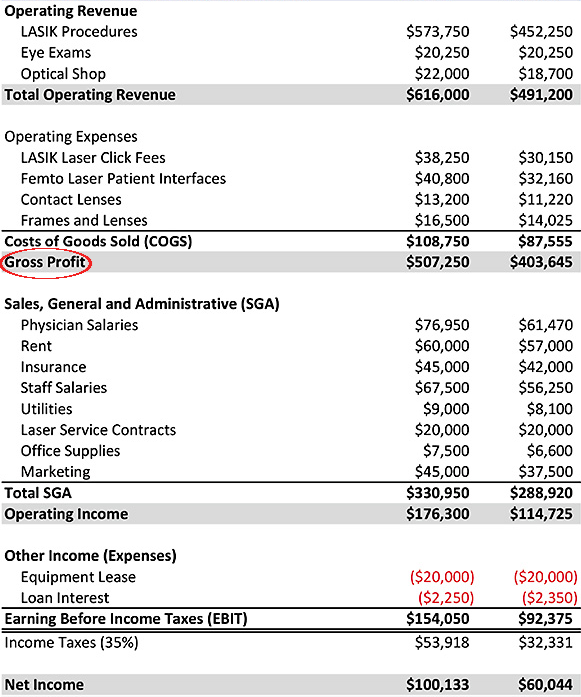Find Gross Profit per Appointment (PLV part 2)
The first step to find patient lifetime value is to find gross profit per appointment. That is, the amount of real money you make from each appointment.
It is reduced by the direct costs you incur for each appointment.
Jump to another section in this series: Finding Patient Lifetime Value
Why use Gross Profit instead of Gross Revenue or Net Profit?
Healthcare providers may have a large number of direct, variable costs or adjustments.
These include eyeglasses for opthamologists, referral fees for counselors or massage therapists, or expendable supplies for dermatologists.
They could include transactional fees for chiropractors or billing fees for primary care physicians. These direct costs also may include labor costs tied to the delivery of care.
Your gross profit should exclude all of the direct costs associated with your appointments. Failing to exclude these costs could result in your business’s closure.
Assume a patient earns you $1,000 in topline revenue. You incur $800 in care, supply, and billing costs. If you fail to deduct the $800 and spend over $200 in patient acquisition, you will lose money for each new patient.
Your gross profit margin will help you know how much tangible value appointments deliver your practice. It will also help you budget for marketing.
Gross profit should not factor in fixed operating costs. Rent, administrative salaries, interest payments, amortization, taxes, and depreciation can be excluded.
These expenses will not increase much for each new appointment. You do not need them for your private practice marketing.
Be careful to use gross profit instead of topline revenue. Using topline revenue can be dangerous for your marketing budget.
Locate Gross Profit in your financials
You can find gross profit in your financial statement. Check your Profit & Loss statement, your Income statement, or ask your accountant.
Find your gross profit from at least the last three years of your financials. Having three will increase the accuracy of all subsequent calculations.
If you do not have an accountant or a reliable Profit & Loss statement, track down your tax returns. Subtract your Cost of Goods Solds or Cost of Services from Gross Revenue from each of the last three years.
Alternatively, your Practice Management System or EHR may help. You will want to look for net receivables or a payments report.
You should exclude revenue that does not arise from appointments. Money from speaking engagements or referrals should be left out. If included, this money will inflate your patient lifetime value.
Find total patient appointments or encounters
Once you have found gross profit, find the total appointments for each of these years.
You will want this data for at least the last three years. One or two is okay if you do not have three years of data. Once again, exclude the current year.
You can usually find a total appointment report in your practice management system. It is often called an Encounter Summary.
An “encounter” is the revenue cycle term for an appointment that converts. That is, it actually happened. It is billable.
Your practice may represent multiple specialties and service types. A patient may routinely undergo two or more different services on a single day. If you run an urgent care center, for example, you might vaccinate a patient, x-ray them, and treat a fracture. If so, use “episodes” in place of “encounters” from here on. An episode can include multiple encounters.
Find the total number of encounters for all providers of your practice. If your specialty does not use the term encounters, count the number of appointments.
Here is a sample Encounters Summary report. The total number of encounters for this year is circled at the bottom.
Calculate Gross Profit per Appointment
Once you have total encounters or appointments, you will be able to find your gross profit per appointment (or gross profit per episode). Simply divide your gross profit by the number of encounters for a given year.
Repeat this calculation for each of the last three, full years.
- Gross Profit per Appointment Year 1 = (Gross Profit Year 1) / (Number of Encounters Year 1)
- Gross Profit per Appointment Year 2 = (Gross Profit Year 2) / (Number of Encounters Year 2)
- Gross Profit per Appointment Year 3 = (Gross Profit Year 3) / (Number of Encounters Year 3)
Now, add these three figures and divide by three to find your average Gross Profit per Appointment. Technically, this is Gross Profit per Encounter. But this term is not as popular.
You will use Gross Profit per Appointment to find Patient Lifetime Value. It is also a vital metric of your practice’s financial health. Be sure to calculate it every year.
Now that you have found Gross Profit per Appointment, you must find your patient recall time.








